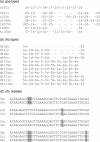Characterization of methicillin-resistant Staphylococcus aureus isolates from food and food products of poultry origin in Germany
- PMID: 21724898
- PMCID: PMC3194878
- DOI: 10.1128/AEM.00561-11
Characterization of methicillin-resistant Staphylococcus aureus isolates from food and food products of poultry origin in Germany
Abstract
During a survey of fresh chicken and turkey meat as well as chicken and turkey meat products for the presence of methicillin-resistant Staphylococcus aureus (MRSA) isolates in Germany, 32 (37.2%) of 86 samples were MRSA positive. Twenty-eight of these MRSA isolates belonged to clonal complex 398 (CC398), which is widespread among food-producing animals. These CC398 isolates carried SCCmec elements of type IV or V and exhibited spa type t011, t034, t899, t2346 or t6574 and either the known dru types dt2b, dt6j, dt10a, dt10q, dt11a, dt11v, and dt11ab or the novel dru types dt6m, dt10as, and dt10at. In addition, two MRSA sequence type 9 (ST9) isolates with a type IV SCCmec cassette, spa type t1430, and dru type dt10a as well as single MRSA ST5 and ST1791 isolates with a type III SCCmec cassette, spa type t002, and dru type dt9v were identified. All but two isolates were classified as multiresistant. A wide variety of resistance phenotypes and genotypes were detected. All isolates were negative for the major virulence factors, such as Panton-Valentine leukocidin, toxic shock syndrome toxin 1, or exfoliative toxins. In contrast to the MRSA CC398 isolates, the four ST9, ST5, or ST1791 isolates harbored the egc gene cluster for enterotoxin G, I, M, N, O, and U genes. Although the relevance of contamination of fresh poultry meat or poultry products with MRSA is currently unclear, the presence of multiresistant and, in part, enterotoxigenic MRSA emphasizes the need for further studies to elucidate possible health hazards for consumers.
Figures
References
-
- CLSI 2008. Performance standards for antimicrobial disk and dilution susceptibility test for bacteria isolated from animals; approved standard, 3rd ed. CLSI document M31-A3 Clinical and Laboratory Standards Institute, Wayne, PA
-
- CLSI 2010. Performance standards for antimicrobial susceptibility testing; 20th informational supplement. CLSI document M100-S20 Clinical and Laboratory Standards Institute, Wayne, PA
-
- de Boer E., et al. 2009. Prevalence of methicillin-resistant Staphylococcus aureus in meat. Int. J. Food Microbiol. 134:52–56 - PubMed
-
- de Jonge R., Verdier J. E., Havelaar A. H. 2010. Prevalence of meticillin-resistant Staphylococcus aureus amongst professional meat handlers in the Netherlands, March-July 2008. Euro Surveill. 15:pii: 19712. - PubMed
-
- Dullweber A. 2010. Occurrence of methicillin-resistant Staphylococcus aureus (MRSA) in poultry flocks. Dissertation Tierärztliche Hochschule, Hannover, Germany: http://elib.tiho-hannover.de/dissertations/dullwebera_ws10.pdf
Publication types
MeSH terms
Substances
LinkOut - more resources
Full Text Sources
Medical


